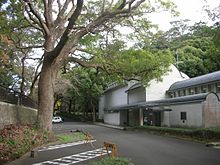Nakagawa Kazumasa
Nakagawa Kazumasa ( Japanese 中 川 一 政 ; born February 14, 1893 in Tokyo Prefecture ; died February 5, 1991 ) was a Japanese painter in the western style ( Yōga ) of the Taishō and Shōwa periods . He also wrote poems and numerous essays.
life and work
After graduating from middle school, Nakagawa lived in Ashiya in Hyōgo prefecture for a year and a half from 1913 . During this time he was influenced by the magazine " Shirakaba " and the Bible. In the summer of 1914 he began to paint in oil. In the same year he returned to Tōkyō, where his picture "Rice Wine Storage" ( 酒 蔵 Sakegura ) was shown in the 14th exhibition of Tatsumi Gakai ( 巽 画 会 ). The next year he visited Kishida Ryūsei , with whom he befriended. In October of that year he was included in the group Sōdosha ( 草 土 社 ), which had been organized by Ryūsei and the painter Kimura Sōhachi ( 木村 荘 八 ; 1893-1958). About Ryūsei he became known to the writers Mushanokōji Saneatsu , Shiga Naoya and other members of the artist group Shirakaba .
In 1915 Nakagawa showed works at the 2nd exhibition of the Nika-kai ( 二 科 会 ) and at the 8th exhibition in 1921 three works, including "Still Life" ( 静物 Seibutsu ), for which he received a prize. When the artist community Shun'yō-kai ( 春陽 会 ) came together in 1922 , he was invited as a guest member , along with Ryūsei, Yorozu Tetsugorō and Saitō Yori ( 斎 藤 与 里 ; 1885-1959). He also became known with his illustrations for Ozaki Shirō's novel "Human Theater" ( 人生 劇場 Jinsei gekijō ) and illustrations in newspapers. In 1925 Nakagawa published a book about Van Gogh , under whose influence he was for a while. In 1927 he joined the Rōsō-kai, which had been formed by Kosugi Hōan . Until 1945 he held lectures on classical Chinese art. From 1938 to 1943 he was a juror for the state art exhibition "Teiten" ( 帝 展 ).
After 1945 he continued to show pictures at the Shun'yō-kai exhibitions, but also at other exhibitions, such as the Shūsaku bijutsu-ten ( 秀 作 美術展 ). From 1954 to 1955 he traveled to Europe for the first time. In 1958 he showed the picture "Strawberry in a Jug" ( 苺 と あ か え の 鉢 Ichigo to akae no hachi ) at the Pittsburgh International Exhibition of Modern Painting and Sculpture. In 1948 and 1964 he traveled through China. - In 1975 Nakagawa was awarded the Order for Cultural Merit .
Based on a Japanese variant of Fauvism , Nakagawa developed his own powerful style. His works after 1945 include "Marien-Garten" (マ リ ア 園, Maria-en ; 1959), "Blick auf Onomichi " ( 尾 道 展望 Onomichi tembō ; 1962). There are also numerous pictures with rose vases. His literary legacy includes the collection of poems “The Mountain Opposite” ( 向 ふ 山 Mukau yama ; 1953), a collection of essays “Invisible World” ( 見 え な い 世界 Mienai sekai ; 1954), “Notes from the grass by the wayside” ( 道 芝 の 記 Michishiba no ki ; 1959) and "Snow on Mount Kōro" ( 香爐峰 の 雪 Korō-hō no yuki ; 1950).
In Manazuru ( Kanagawa Prefecture ) the Nakagawa Kazumasa Art Museum ( 中 川 一 政 美術館 ) shows part of the work, gives guided tours and does educational work.
Web links (images)
literature
- Suzuki, Toshihiko (Ed.): Nakagawa Kazumasa . In: Nihon daihyakka zensho (Denshibukku-han) . Shogakukan, 1996.
- Tazawa, Yutaka: Nakagawa Kazumasa . Kodansha International, 1981, ISBN 0-87011-488-3 .
- Laurance P. Roberts: Nakagawa Kazumasa . In: A Dictionary of Japanese Artists . Weatherhill, 1976, ISBN 0-8348-0113-2 .
Web links
| personal data | |
|---|---|
| SURNAME | Nakagawa, Kazumasa |
| ALTERNATIVE NAMES | 中 川 一 政 (Japanese) |
| BRIEF DESCRIPTION | Japanese painter |
| DATE OF BIRTH | February 14, 1893 |
| PLACE OF BIRTH | Tokyo prefecture |
| DATE OF DEATH | 5th February 1991 |
